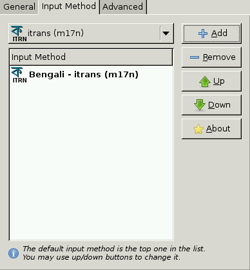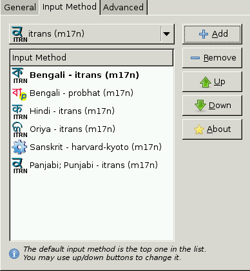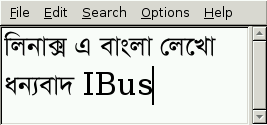- bn-inscript
- bn-probhat
NOTE: ibus-qt4 - qt-immodule for ibus (QT4)
Installation
As root execute
required
dependencies will be installed automatically by apt.
Confirm the system now have Bengali input method
#dpkg -L m17n-db | grep bn
/usr/share/m17n/icons/bn-itrans.png
/usr/share/m17n/icons/bn-unijoy.png
/usr/share/m17n/bn-itrans.mim
/usr/share/m17n/bn-unijoy.mim
/usr/share/m17n/bn.lnm#dpkg -L m17n-contrib | grep bn
/usr/share/m17n/bn-inscript.mim
/usr/share/m17n/bn-probhat.mim
/usr/share/m17n/icons/bn-inscript.png
/usr/share/m17n/icons/bn-probhat.png
.mim file is the file whre the
input method of the keymap layout of the concerened language is defined
| Setup |
I am using icewm Window manager and no Desktop manager at all. Your setup may differ. But the following should be valid for all. Tested with xfce4
Use any xterminal of your choice and execute
-d makes ibus-daemon actually run as a daemon.
-x starts the ibus xim server so that applications that only use xim can use it. You can skip this based on your aplication
-r this is important. It re-starts ibus. If you don't have this, ibus will work OK the first time you log in. However when you log out ibus might still be running unless you kill the instance or some other arrangement to do the same. When you log in again, "ibus-daemon -dx" will be called and does nothing if it is already running. The problem is that the running version of ibus expects a different session (the one you logged out of) and as a result you won't see the IBus applet at systray. It's still usable in this state, but missing the applet where you can control/configure IBus.
Confirm that the daemon is running
|
You can see the ibus applet at the system tray area. Right click on it --> preferences
If you can't get the system tray applet then execute equivalent command ibus-setup




So you are done now.
If you left-click on the applet you see "No Input window". Don't be panic. It is saying there is no application where IBus can write.
| Testing |
Open leafpad editor ; keeping the mouse there ( so that ibus can detect its input area ) press [ctrl]+[space]. This enables ( unless you change the key combination ) the IME. You can see the system tray applet has been changed to indicate the selected Input Method.

Enter some Bengali text now

| How to auto start ibus-daemon |
You can put "ibus-daemon -xrd" at the autostart section of your Desktop manager / window manager. It is .icewm/startup for icewm
or you can put it at .xinitrc
sleep 3
ibus-daemon -xrd
icewm-session
